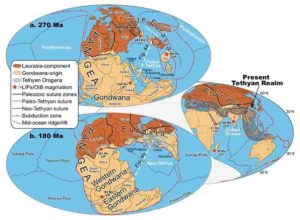
Plate tectonics was founded in the late 1960s, and it concerns the distribution and movements of plates, the uppermost layer of the Earth. Plate movements not only control the distributions of earthquakes, volcanoes, and mineral resources in the crust, but also affect the ocean and atmospheric circulations above the crust. Therefore, plate tectonics has been regarded as the fundamental unifying paradigm for understanding the history of Earth.
Despite the widely accepted kinematics of plate tectonics, the driving force of plate tectonics is still one of the most challenging problems since the birth of this theory. The subduction of oceanic slabs is considered the dominant driving force based on observations of Cenozoic subduction systems along the circum-Pacific region. However, the difficulty in observing the oceanic subduction slabs beneath collisional orogens hampers the ability to quantitatively evaluate the role of subducting oceanic slabs. Alternative driving forces such as ridge push, continental slab-pull, plume upwelling and large-scale mantle convection have been proposed at different subduction-collision belts along the Tethyan Realm (Fig 1), the largest continental collisional zone. The Tethyan evolution can be summarized as the process by which many continental fragments were ruptured sequentially from Gondwana and then drift towards Laurasia/Eurasia.
Scientists from the State Key Laboratory of Lithospheric Evolution, Institute of Geology and Geophysics, Chinese Academy of Sciences in Beijing found “switches” between continental rupture, continental collision, and oceanic subduction initiation in the Tethyan evolution after a reappraisal of geological records from the surface and new global-scale geophysical images at depth. They proposed that the “switches” were all controlled by oceanic subductions. All oceanic Tethyan slabs acted in a way that transferred the Gondwana-detached continents in the south into the terminal in the north, so they depicted the scenario as a “Tethyan one-way train” (Figure. 2a and b). The engine of the “train” was the negative buoyancy of the subducting oceanic slabs. The results also shed light on supercontinent assembly and breakup cycles. Subductions not only assemble the supercontinent but also effectively break-up the supercontinent.
The new results will not close the discussions on driving force of plate tectonics, but future Tethyan research may test the new proposal and improve the understanding of how plate tectonics works.
Reference:
Bo Wan et al, Cyclical one-way continental rupture-drift in the Tethyan evolution: Subduction-driven plate tectonics, Science China Earth Sciences (2019). DOI: 10.1007/s11430-019-9393-4
Note: The above post is reprinted from materials provided by Science China Press.










